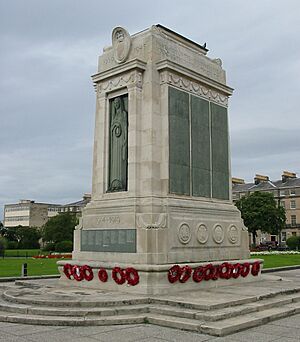Birkenhead War Memorial facts for kids
The Birkenhead War Memorial, also called the Birkenhead Cenotaph, is a special monument in Hamilton Square, Birkenhead, Merseyside, England. It stands right across from the Town Hall. This memorial is made from Portland stone and features beautiful carvings and panels made of Westmorland stone. It was designed by Lionel Bailey Budden and the sculptures were created by H. Tyson Smith. The memorial was officially revealed in 1925 by Lieutenant-General Sir Richard H. K. Butler. It is considered a very important historical building, listed as Grade II* on the National Heritage List for England.
History of the Birkenhead War Memorial
After the First World War, many towns wanted to build memorials to remember those who had died. In 1922, a special committee in Birkenhead held a competition. They asked designers to create a war memorial for the town.
Twenty-one different designs were submitted. These designs were shown to the public at the Birkenhead Art Gallery and Museum in February 1923. Most of the designs were in a Classical style. This style was similar to the famous Cenotaph in Whitehall, London.
The designs were looked at by Charles Herbert Reilly. He was a professor at the University of Liverpool School of Architecture. He liked the design by Lionel Budden, who used to be his student. Budden was a senior lecturer at the same school. Major Gilbert Fraser, who was the President of the Liverpool Architectural Society, chose Budden's design. The committee agreed with this choice.
Lionel Budden then chose H. Tyson Smith to create the sculptures for the memorial. The memorial itself was built by Joseph Davies of Birkenhead and H. A. Clegg and Sons of Chester.
At first, the plan was to put the memorial on the north side of Hamilton Square. But many people strongly felt it should be on the east side. This spot was opposite the Town Hall. An old statue of John Laird was already there. So, it was decided to move the Laird statue to the west side of the square. The war memorial would take its place.
The memorial was officially unveiled on July 1, 1925. Sir Richard H. K. Butler led the ceremony. About 20,000 people came to watch. After the Second World War, the names of those who died in that war were also added to the memorial. In 1987, the monument was taken away for two months for repairs. Then, in 2013, it was cleaned and made to look new again.
What the Memorial Looks Like
The Birkenhead War Memorial is made mostly of Portland stone. The figures and the names of the fallen are carved from Westmorland stone. The memorial stands about 7.6 metres (25 feet) tall. It has a rectangular shape, with the longer sides facing east and west.
The monument stands on three steps on a paved area. There are flagpoles on either side of it. On the longer sides, you can see panels with the names of those who died in the First World War. On the shorter sides, in smaller panels, are the names of those who died in the Second World War.
Above these smaller panels on the shorter sides, there are carvings of female figures. One figure holds a wreath, which is a circle of flowers. The other holds a medallion, which is a round piece of art. Above all the figures and panels, there is a decorative band called a frieze. This frieze shows festoons of laurel, which are like garlands of leaves.
Below the panels on the long sides, there are round plaques. These plaques are carved with the symbols, or crests, of the different armed forces that fought in the wars. Above the figures on the short sides, you can see the coat of arms for Birkenhead. The very top of the memorial looks like a sarcophagus, which is a stone coffin. The total cost to build this memorial was about £3,932.
On the east side, which faces the Town Hall, there is an important message. It says:
- IN MEMORY OF THE MEN OF BIRKENHEAD
- WHO GAVE THEIR LIVES IN THE GREAT WAR
On the opposite long side, another message is carved:
- ALL THESE WERE HONOURED IN THEIR GENERATIONS
- AND WERE THE GLORY OF THEIR TIMES
Inside the medallion held by one of the figures, it says:
- HE DIED FOR FREEDOM AND HONOUR
Above a front ledge, you can read:
- 1939–45
- THE BOOK OF REMEMBRANCE MAY BE INSPECTED IN THE TOWN HALL
The dates "1914–1919" are carved below the figures on the short sides. Above them, it says "1939 1945 WAR". The names of the sculptor and the architect are also written on the memorial.
Why the Memorial is Important
The Birkenhead War Memorial is listed as a Grade II* building on the National Heritage List for England. It was given this special status on March 28, 1974.
What does Grade II* mean? In England, buildings are given different grades to show how important they are. Grade II* is the second highest grade. It means the building is "particularly important" and has "more than special interest." This shows how much the Birkenhead War Memorial means to the history and heritage of the area.


